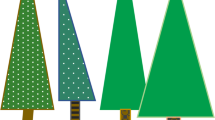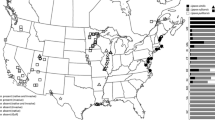Abstract
The density of insect herbivores is regulated by top-down factors (e.g., natural enemies), bottom-up effects (e.g., plant defenses against herbivory), or a combination of both. As such, understanding the relative importance of these factors can have important implications for the establishment of effective management options for invasive species. Here, we compared the relative importance of top-down and bottom-up factors on the abundance of hemlock woolly adelgid (HWA), Adelges tsugae. HWA is invasive in eastern North America, but its native range includes the Pacific Northwest of North America where it has co-evolved with western hemlock, Tsuga heterophylla. Eastern hemlock, Tsuga canadensis, can also be found planted in city and park settings in the Pacific Northwest and the presence of both host species allowed us to directly compare the importance of predators (top-down) and host plant resistance (bottom-up) on HWA abundance by placing mesh exclusion bags on branches of both species and monitoring HWA abundance over two years. We found no evidence for bottom-up control of HWA on western hemlock (a native host). HWA established more readily on that species than on eastern hemlock on which it is a major pest in eastern North America. We found strong evidence for top-down control in that both summer and winter-active predators significantly reduced HWA densities on the branches of both tree species where predators were allowed access. These findings support the validity of the biological control program for HWA, the goal of which is to reduce outbreak populations of HWA in eastern North America.


Similar content being viewed by others
Data availability
The datasets used and/or analyzed during the current study are available from the corresponding author on reasonable request.
Code availability
The R-script used to analyze the dataset used and/or analyzed during the current study is available from the corresponding author on reasonable request.
References
Bates D, Maechler M, Bolker B, Walker S (2015) Fitting linear mixed-effects models using lme4. J Stat Softw 67:1–48. https://doi.org/10.18637/jss.v067.i01
Bentz SE, Riedel LGH, Pooler MR, Townsend AM (2002) Hybridization and self-compatibility in controlled pollinations of eastern North American and Asian hemlock (Tsuga) species. J Arboric 28:200–205
Biedermann PH, Müller J, Grégoire JC, Gruppe A, Hagge J, Hammerbacher A, Hofstetter RW, Kandasamy D, Kolarik M, Kostovcik M, Krokene P (2019) Bark beetle population dynamics in the anthropocene: challenges and solutions. Trends Ecol Evol 34:914–924. https://doi.org/10.1016/j.tree.2019.06.002
Cheah C, Montgomery ME, Salom S, Parker BL, Costa S, Skinner M (2004) Biological control of hemlock woolly adelgid. USDA Forest Service Forest Health Enterprise Team, Technology Transfer, Morgantown
Crandall RS, Jubb CS, Mayfield AE, Thompson B, McAvoy TJ, Salom SM, Elkinton JS (2020) Rebound of Adelges tsugae spring generation following predation on overwintering generation ovisacs by the introduced predator Laricobius nigrinus in the eastern United States. Biol Control 145:104–264. https://doi.org/10.1016/j.biocontrol.2020.104264
Del Tredici P, Kitajima A (2004) Introduction and cultivation of Chinese hemlock (Tsuga chinensis) and its resistance to hemlock woolly adelgid (Adelges tsugae). J Arboricul 30:282–287
Denno RF, McClure MS, Ott JR (1995) Interspecific interactions in phytophagous insects: competition reexamined and resurrected. Annu Rev Entomol 40:297–331
Elkinton JS, Trotter RT, Paradis AF (2011) Simulation of population dynamics of hemlock woolly adelgid and potential impact of biological control agents. In: Onken B, Reardon R (eds) Implementation and status of biological control of the hemlock woolly adelgid. USDA Forest Service FHTET, Morgantown
Foley JR, McAvoy TJ, Dorman S, Bekelja K, Kring TJ, Salom SM (2019) Establishment and distribution of Laricobius spp (Coleoptera: Derodontidae), a predator of hemlock woolly adelgid, within the urban environment in two localities in southwest Virginia. J Integr Pest Manag 10:30. https://doi.org/10.1093/jipm/pmz027
Foottit RG, Maw HEL, Havill NP, Ahern RG, Montgomery ME (2009) DNA barcodes to identify species and explore diversity in the Adelgidae (Insecta: Hemiptera: Aphidoidea). Mol Ecol Resour 9:188–195. https://doi.org/10.1111/j.1755-0998.2009.02644.x
Fretwell SD, Barach AL (1977) The regulation of plant communities by the food chains exploiting them. Perspect Biol Med 20:169–185. https://doi.org/10.1353/pbm.1977.0087
Hairston NG, Smith FE, Slobodkin LB (1960) Community structure, population control, and competition. Amer Natur 94:421–425. https://doi.org/10.1086/282146
Havill NP, Montgomery ME (2008) The role of arboreta in studying the evolution of host resistance to the hemlock woolly adelgid. Arnoldia 65:2–9
Havill NP, Montgomery ME, Yu G, Shiyake S, Caccone A (2006) Mitochondrial DNA from hemlock woolly adelgid (Hemiptera: Adelgidae) suggests cryptic speciation and pinpoints the source of the introduction to eastern North America. Mol Ecol 99:195–203
Havill NP, Vieira LC, Salom SM (2014) Biology and control of hemlock woolly adelgid. USDA Forest Service FHTET, Morgantown
Havill NP, Shiyake S, Lamb Galloway A, Foottit RG, Yu G, Paradis A, Elkinton J, Montgomery ME, Sano M, Caccone A (2016) Ancient and modern colonization of North America by hemlock woolly adelgid, Adelges tsugae (Hemiptera: Adelgidae), an invasive insect from East Asia. Mol Ecol 25:2065–2080. https://doi.org/10.1111/mec.13589
Hoover BK, Bates RM, Sellmer JC, Hoover GA (2009) Challenging Chinese hemlock (Tsuga chinensis) with hemlock woolly adelgid (Adelges tsugae) ovisacs. Arboricult Urban for 35:1–4
Hovick SM, Carson WP (2015) Tailoring biocontrol to maximize top-down effects: on the importance of underlying site fertility. Ecol Appl 25:125–139. https://doi.org/10.1890/13-2050.1
Hunter MD, Price PW (1992) Playing chutes and ladders: heterogeneity and the relative roles of bottom-up and top-down forces in natural communities. Ecol 73:724–732
Jetton RM, Hain FP, Dvorak WS, Frampton J (2008) Infestation rate of hemlock woolly adelgid (Hemiptera: Adelgidae) among three North American hemlock (Tsuga) species following artificial inoculation. Entomol Sci 43:438–442. https://doi.org/10.18474/0749-8004-43.4.438
Joseph SV, Braman SK, Hanula JL (2011) Effects of fertilization of four hemlock species on Adelges tsugae (Hemiptera: Adelgidae) growth and feeding preference of predators. J Econ Entomol 104:288–298. https://doi.org/10.1603/EC10163
Jubb CS, Heminger AR, Mayfield AE III, Elkinton JS, Wiggins GJ, Grant JF, Lombardo JA, McAvoy TJ, Crandall RS, Salom SM (2020) Impact of the introduced predator, Laricobius nigrinus, on ovisacs of the overwintering generation of hemlock woolly adelgid in the eastern United States. Biol Control 143:104180. https://doi.org/10.1016/j.biocontrol.2019.104180
Jubb CS, McAvoy TJ, Stanley KE, Heminger AR, Salom SM (2021) Establishment of the predator Laricobius nigrinus, introduced as a biological control agent for hemlock woolly adelgid in Virginia, USA. Biocontrol 66:367–379. https://doi.org/10.1007/s10526-020-10072-5
Kohler GR, Wallin KF, Ross DW (2016) Seasonal phenology and abundance of Leucopis argenticollis, and Leucopis piniperda (Diptera: Chamaemyiidae), Laricobius nigrinus (Coleoptera: Derodontidae) and Adelges tsugae (Hemiptera: Adelgidae) in the Pacific Northwest USA. Bull Entomol Res 106:546–550. https://doi.org/10.1017/S0007485316000250
Lappanen C, Fordyce JA, LeBude AV, Ranney TG, Simberloff D (2019) Variable colonization by the hemlock woolly adelgid suggest infestation is associated with hemlock host species. Biol Invas 21:2891–2906. https://doi.org/10.1007/s10530-019-02020-x
Lawton JH, Strong DR (1981) Community patterns and competition in folivorous insects. Am Nat 118:317–338. https://doi.org/10.1086/283826
Mausel DL (2005) Observations on fecundity and natural enemies of hemlock woolly adelgid, Adelges tsugae Annand (Hemiptera: Adelgidae) in Seattle, Washington. Pan-Pac Entomol 81:97–98
Mausel DL, Salom SM, Kok LT, Davis GA (2010) Establishment of the hemlock woolly adelgid predator, Laricobius nigrinus (Coleoptera: Derodontidae), in the eastern United States. Environ Entomol 39:440–448. https://doi.org/10.1603/EN09088
McClure MS (1987) Biology and control of hemlock wooly adelgid, Bulletin. The Connecticut Agricultural Experiment Station, New Haven
McClure MS (1991) Density-dependent feedback and population cycles in Adelges tsugae (Homoptera: Adelgidae) on Tsuga canadensis. Environ Entomol 20:258–264. https://doi.org/10.1093/ee/20.1.258
McClure MS (1992) Hemlock woolly adelgid. Am Nurseryman 15:82–89
Montgomery ME, Lyon SM (1996) Natural enemies of adelgids in North America: their prospect for biological control of Adelges tsugae (Homoptera: Adelgidae). In Salom SM, Tigner TC, Reardon RC (Eds.) Proceedings of the 1st Hemlock Woolly Adelgid Review; 1995 October 12; Charlottesville, VA. USDA Forest Service, Forest Health Technology Enterprise Team 96–10. Morgantown, WV: 89–101
Murdoch WW (1966) “Community structure, population control, and competition” - a critique. Am Nat 100:219–226. https://doi.org/10.1086/282415
Oksanen L, Fretwell SD, Arruda J, Niemela P (1981) Exploitation ecosystems in gradients of primary productivity. Am Nat 118:240–261. https://doi.org/10.1086/283817
Oten KLF (2011) Host-plant selection by the hemlock woolly adelgid, Adelges tsugae Annand: sensory systems and feeding behavior in relation to physical and chemical host-plant characteristics. North Carolina State University, Raleigh
Power ME (1992) Top-down and bottom-up forces in food webs: do plants have primacy. Ecol 73:733–746. https://doi.org/10.2307/1940153
Preisser EL, Lodge AG, Orwig DA, Elkinton JS (2008) Range expansion and population dynamics of co-occurring invasive herbivores. Biol Invas 10:201–213. https://doi.org/10.1007/s10530-007-9123-z
R Core Team (2021) R: a language and environment for statistical computing computer program. R Foundation for Statistical Computing, Vienna, Austria. https://www.R-project.org/
Strong DR, Lawton JH, Southwood SR (1984) Insects on Plants. Community patterns and mechanisms. Harvard University Press, Cambridge
Sussky EM, Elkinton JS (2014) Density-dependent survival and fecundity of hemlock woolly adelgid (Hemiptera: Adelgidae). Environ Entomol 43:1157–1167. https://doi.org/10.1603/EN13356
Sussky EM, Elkinton JS (2015) Survival and near extinction of hemlock woolly adelgid (Hemiptera: Adelgidae) during summer aestivation in a hemlock plantation. Environ Entomol 44:153–159. https://doi.org/10.1093/ee/nvu007
Vidal MC, Murphy SM (2018) Bottom-up vs. top-down effects on terrestrial insect herbivores: a meta-analysis. Ecol Lett 21:138–150. https://doi.org/10.1111/ele.12874
Wallace MS, Hain FP (2000) Field surveys and evaluation of native and established predators of the hemlock woolly adelgid (Homoptera: Adelgidae) in the southeastern United States. Environ Entomol 29:638–644. https://doi.org/10.1603/0046-225X-29.3.638
Weed AS, Elkinton JS, Lany NK (2016) Density-dependent recruitment and diapause in the spring-feeding generation of hemlock woolly adelgid (Hemiptera: Adelgidae) in western North America. Environ Entomol 45:1352–1359. https://doi.org/10.1093/ee/nvw107
Weston PA, Harper RW (2009) Potential of Tsuga spp. from western North America and Asia as replacements for eastern hemlock (Tsuga canadensis). Arboric Urban for 35:5–9
Wickham H (2009) ggplot2: elegant graphics for data analysis. Springer, New York
Young RF, Shields KS, Berlyn GP (1995) Hemlock woolly adelgid (Homoptera: Adelgidae): stylet bundle insertion and feeding sites. Ann Entomol Soc Am 88:827–835. https://doi.org/10.1093/aesa/88.6.827
Zar JH (2010) Biostatistical Analysis, 2nd edn. Prentice-Hall/Pearson, New Jersey
Zilahi-Balogh G, Lamb A, Salom S, Kok L (2003) Seasonal abundance and synchrony between Laricobius nigrinus (Coleoptera: Derodontidae) and its prey, the hemlock woolly adelgid. Can Entomol 135:103–115. https://doi.org/10.4039/n02-059
Acknowledgements
We thank members of the Elkinton Lab for helping with gathering materials (G. Boettner), data collection (A. Langevin, A. Roehrig, J. Chandler, B. Griffin), editing (J. Chandler, J. Andersen, H. Broadley). We thank M. Whitmore, E. Sussky, and E. Hazelton for locating sources of HWA inoculum and/or help with experimental set up. Thanks to N. Havill for identifying insect samples with molecular techniques. We thank R. McDonald for introducing us to the Arboretum. We thank the University of Washington’s Washington Park Arboretum (D. Zuckerman, R. Garrison, and staff) for allowing us to set up our experiment in the arboretum and use their equipment and facilities. We thank D. Orwig and E. Preisser for helpful edits to the manuscript. Finally, we thank the USDA Forest Service (R. Reardon, N. Schneeberger) for funding this project.
Funding
This study was funded by the U.S. Department of Agriculture Forest Service Grant No. 14-CA-11420004–181.
Author information
Authors and Affiliations
Contributions
JE obtained funding and provided overall management of the project. JE and JL formulated the study design. JL and RC collected the data. RC conducted statistical analyses and wrote the manuscript. JE and JL edited drafts of the manuscript.
Corresponding author
Ethics declarations
Conflict of interest
The authors declare that they have no conflicts of interest.
Ethical approval
Not applicable.
Informed consent
Not applicable.
Consent for publication
Not applicable.
Additional information
Communicated by David Donoso.
Supplementary Information
Below is the link to the electronic supplementary material.
Rights and permissions
About this article
Cite this article
Crandall, R.S., Lombardo, J.A. & Elkinton, J.S. Top-down regulation of hemlock woolly adelgid (Adelges tsugae) in its native range in the Pacific Northwest of North America. Oecologia 199, 599–609 (2022). https://doi.org/10.1007/s00442-022-05214-8
Received:
Accepted:
Published:
Issue Date:
DOI: https://doi.org/10.1007/s00442-022-05214-8




